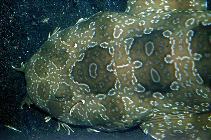
|
Orectolobus maculatus (Bonnaterre, 1788) Spotted wobbegong |

|
|
photo by
JJPhoto |
| Family: | Orectolobidae (Carpet or nurse sharks) | |||
| Max. size: | 320 cm TL (male/unsexed) | |||
| Environment: | reef-associated; marine; depth range 0 - 248 m | |||
| Distribution: | Eastern Indian Ocean: southern Australia, from Western Australia to southern Queensland. Records from Japan and the South China Sea need to be confirmed. | |||
| Diagnosis: | Dorsal spines (total): 0-0; Dorsal soft rays (total): 0-0; Anal spines: 0-0; Anal soft rays: 0-0. Back dark, with light O-shaped markings obscuring darker saddles (Ref. 13577). Caudal fin with its upper lobe hardly elevated above the body axis, with a strong terminal lobe and subterminal notch but no ventral lobe (Ref. 13577). | |||
| Biology: | Found on the continental shelf, from the intertidal down to at least 110 m (Ref. 247). Commonly on coral and rocky reefs, under piers, and on sand bottom (Ref. 247). May occur in water barely deep enough to cover the fish, and has been observed climbing ridges between tide pools with its back out of water (Ref. 247). Nocturnal (Ref. 247). Feeds on bottom invertebrates (Ref. 247), including crabs, lobsters and octopuses (Ref. 43278), and bony fishes (Ref. 247), like sea bass, scorpionfishes and luderick (Ref. 43278). Ovoviviparous (Ref. 43278, 50449), with up to 37 pups in a litter (Ref. 247). Known to bite people that step on it or put their feet near its mouth, and can and will bite when molested and provoked (Ref. 247). Flesh highly regarded and sometimes utilized for human consumption (Ref. 247). Skin sometimes utilized for leather (Ref. 247). Regarded as pest by lobster fishers (Ref. 247). | |||
| IUCN Red List Status: | Least Concern (LC); Date assessed: 23 March 2015 Ref. (130435) | |||
| Threat to humans: | traumatogenic | |||